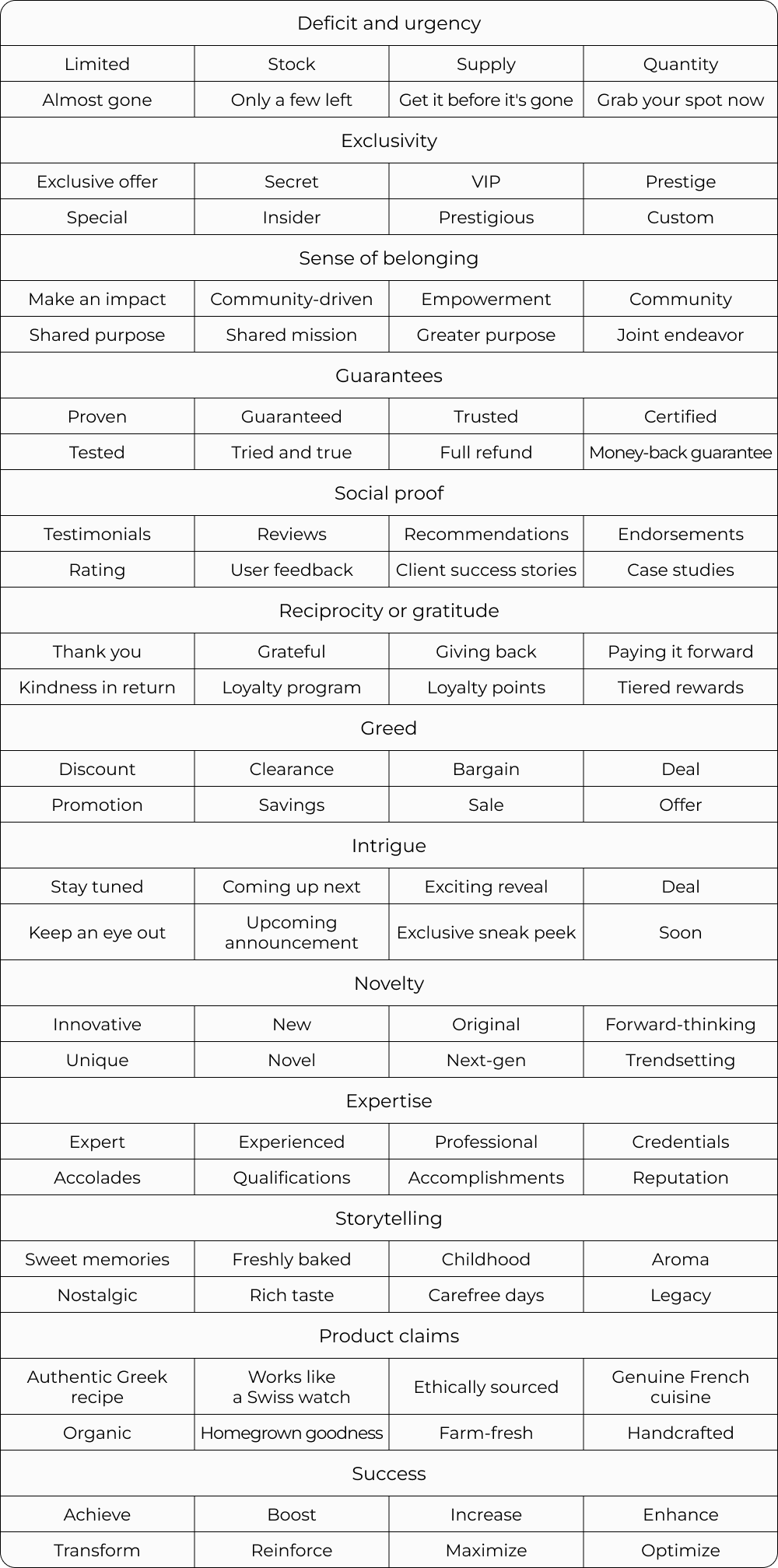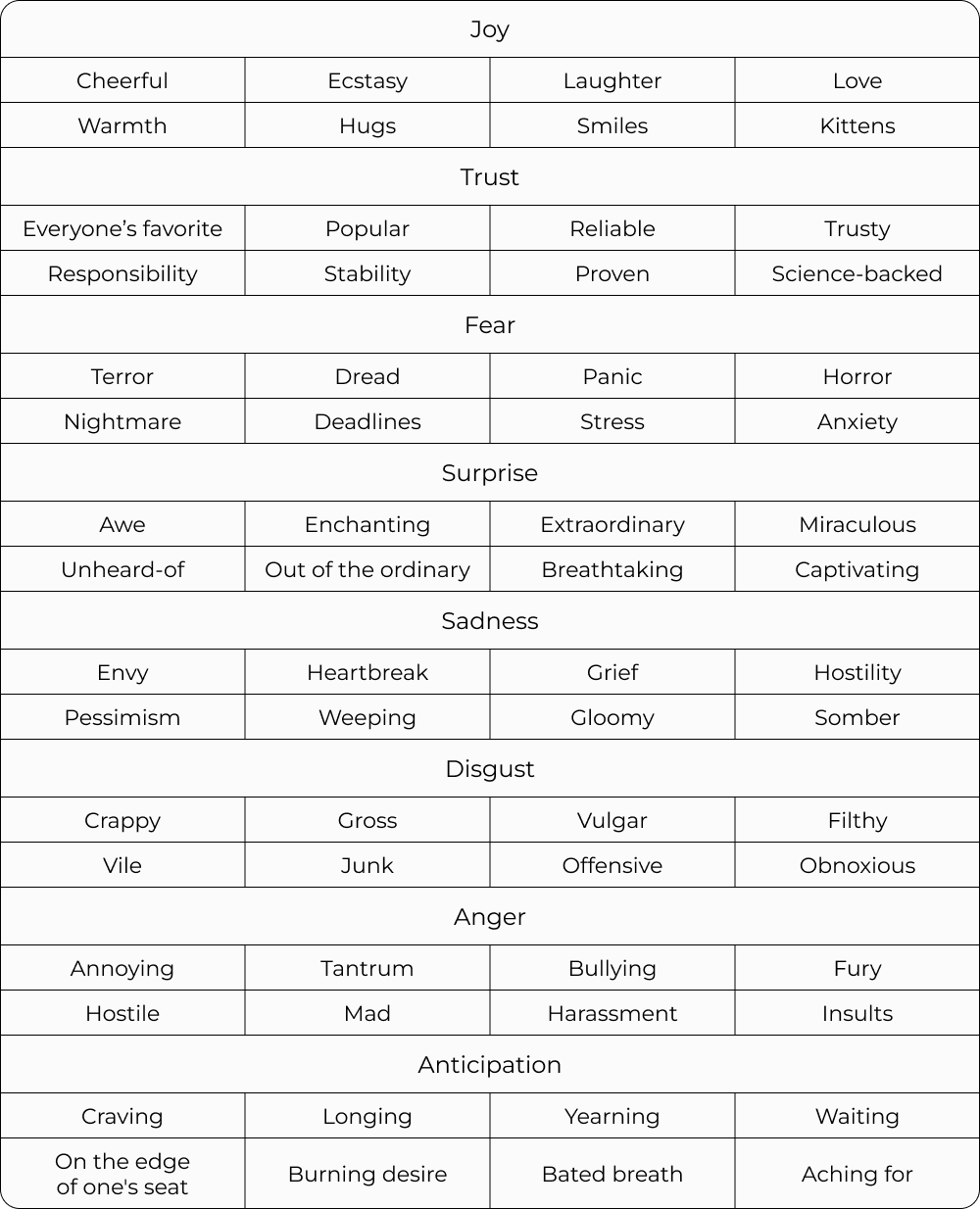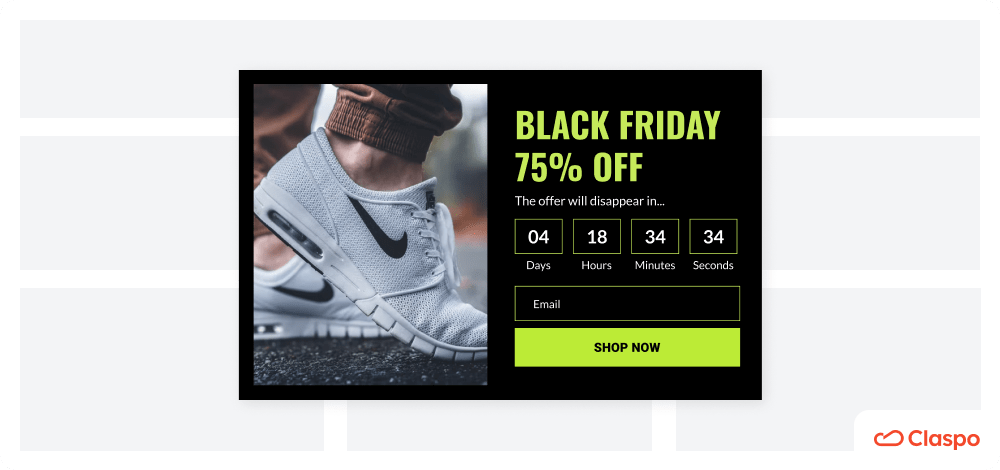256 Trigger Words and Phrases & How to Use Them
Trigger words are designed to affect human emotions and prompt the audience to take a targeted action. Trigger phrases surround us everywhere: on the Internet, in advertising banners, in stores, at work, and in communication with colleagues and friends. This article will look at the most common examples of trigger words, their types, and their practical application.
What Are Trigger Words?
By definition, trigger words are specific phrases or words that trigger emotions in the reader or listener. They are often used in marketing and advertising to influence the target audience's behavior. Trigger words can be positive or negative, designed to tap into readers' or listeners' emotions and encourage them to act.
For example, some trigger words commonly used in marketing include “limited-time offer,” “exclusive,” “free,” etc. These words are constructed to create a sense of urgency, exclusivity, value, or trust in the reader or listener's mind and encourage them to take action, such as purchasing, signing up for a service, or subscribing to a newsletter.
Why Do Trigger Words Work?
Trigger words work because they tap into the emotions of the reader or listener and create a strong psychological response. Using trigger words in advertising and marketing is based on the principle that people make decisions based on their emotions rather than purely rational thought. When people see or hear words that trigger emotions, they are more likely to engage with the content and take action.
Ads that trigger strong emotions convert 70% of customers, compared to 30% of ads that evoke mild emotions. Moreover, 95% of all purchasing decisions are made based on subconscious factors, many of which are rooted in emotions. So, appealing to your customers' emotional side is a good way to gain additional conversions.
Trigger words can also create a sense of curiosity or intrigue, motivating people to learn more about a product or service. In general, emotionally charged campaigns show almost double the success rate of rationally oriented campaigns, allowing you to effectively drive conversions and sales, encourage users to participate in various events, prevent cart abandonment, and more.
Types of Triggers in Marketing
Now that we know what a trigger word is, let’s examine different types and how you can apply them to your marketing campaigns.
Direct emotional appeal
Humans are not defined by their emotions, but they certainly let emotions lead them in many cases. Appealing to emotions is the oldest marketing trick in the book. Warm words like “hugs” and “kittens” can incite joy, “heartbreak” can bring sadness, and the mere mention of “taxes” can bring out the worst in us (joke).
Back in 1980, Professor Robert Plutchik visualized human emotions in a diagram. While it’s not the perfect representation of the full spectrum of emotions, it’s a great approximation. Use it to guide your trigger word usage.

Deficit and urgency
Urgency and deficit triggers are tightly connected, so we’re lumping them together.
An artificially created product shortage forces users to purchase a product faster. People fear losing something, especially if they like a product or brand. For example, “only 3 suits left from a famous brand,” “hurry up and sign up for an English language group: only one place remaining,” and “a limited number of goods.”
Another marketing trigger is limited sales time. In this case, the trigger works for the installation: do it now because access will be closed tomorrow. For example, “Today only - 15% discount on all products” with a timer set on the site ticking down until the end of the promotion.
Exclusivity
This marketing trigger plays on the desire to be different—to stand out and attract attention. 94% of buyers admit they’d take an exclusive offer any time of the day. Marketers can use this desire to feel special with specific deals reinforced with strong trigger words.
For example, a luxury car—only 8 models were made, clothes from a famous fashion designer, and individual production of accessories and jewelry. Either it is a subscription for VIP clients, an exclusive offer for regular users, or closed access to a community or group.
Sense of belonging
This trigger is used in marketing to make users feel like they’re a part of something bigger—a cause or a community. In 1943, Abraham Maslow created the theory about the “hierarchy of needs.” Unsurprisingly, a healthy community can help solve the need for self-actualization, esteem, belonging, love, and safety. That’s half the human’s needs solved by a good group of people working together. While a cause doesn’t tick as many boxes, it still helps you with the need for self-actualization.
We humans need to be dedicated members of a community or simply donate to charity to try to make the world better.
Words and phrases like “empowerment,” “community-driven,” and “make an impact” are just some frequently used examples.
Guarantees
This trigger builds trust in a brand or product. Guarantees can be quality certificates, free services, and the ability to return money for goods. “100% satisfaction guarantee” or “Lifetime warranty” are good examples from this category.

Social proof
When you post information that 1,000 people have bought a product and 900 recommend it, 43% of users will use it to make their purchasing decision. This is how social proof works.
For example, “300,000 people have already appreciated the quality of mattresses”, “50,000 customers use our services every day”, and “250 families have already received the keys to a new apartment”. The famous phrase about “9 out of 10 dentists” wasn’t born out of nothing.
Reciprocity or gratitude
The principle of reciprocity forces the user to feel obligated. If you offer a customer a gift, a free subscription, or a product sample, they will feel compelled to give something in return: their contact info, feedback, recommendations to friends and family, or even a purchase.
Loyalty programs are among the most popular strategies, considering around 90% of companies have some kind of loyalty program. They build connections with returning buyers and incentivize new customers to become permanent visitors to your store.
If you want to use this principle, trigger words like “gift,” “bonus,” and “loyalty card” are likely to be your best bets.
Greed
This is the most prevalent trigger in marketing promotions, discounts, and sales. The user gets the feeling that they pay less for the product, for example, low prices during Black Friday, a sale of goods with a 50% discount, or a “2 for the price of 1” promotion.
Intrigue
Start talking about your new and mysterious project that will turn the world upside down, but cut off the story with the trigger phrase: “In the next post, I will tell you what kind of project it is.” This will create an air of mystery and make many customers follow you. Words like “anticipated,” “long-awaited,” and “countdown” can help you set the intrigue.
Just don’t forget to set the expectation level right. You don’t want to put the bar too high and then underdeliver on your promises.
Novelty
This trigger works on the desire to have something new or be the first to know the latest news. People experience a sense of joy and satisfaction from new things. For example, buying the “latest iPhone” or a “brand new video game.”

Expertise
It stimulates the growth of trust in the company or brand. Certificates, diplomas, other awards, achievements, and experience confirm expertise.

Storytelling
A story about a company, brand, product, or achievement: the essence of the trigger is to involve the user in the story and play on associations, like childhood memories, the taste of food, or a familiar melody.
Simplicity
This technique helps create a simple path for the client: “buy in one click,” “get fit in 3 easy steps,” and “use the application to order a taxi quickly.”
Product claims
These triggers are used to appeal to consumers by suggesting certain desirable qualities or attributes of a product. Remember food packaging? “Environmentally friendly packaging,” “original Italian recipe,” and “farm-fresh ingredients”—all these belong to stereotypes.

Success
Something every person strives for is success. And although everyone views it differently, the majority of words used to convey the idea are quite similar. You probably can’t count how many times you’ve seen words like “success,” “boost,” and “enhance.” That’s because they’re effective drivers of attracting people looking for success.
For example, take a look at our client Devart. They used trigger words from this category like “faster routines,” “performance boost,” and so on. This technique, combined with Claspo's super-efficient widgets and the use of statistics for authority and trustworthiness, allowed Devart to achieve a radical 48% increase in product downloads and a 26.7% increase in conversion rate.

How To Use Trigger Words To Amplify Your Marketing
Here are some tips for using trigger words to amplify your marketing:
- Context is important. Imagine we told you to “hurry up” because it is a “limited-time offer,” and then you learn it’s a permanent deal that’s been available since the dawn of time. Makes no sense, right? Always ensure your trigger words make sense in context.
- Know your audience. Before using trigger words in your marketing, it's important to understand your target audience and what triggers them emotionally. This can help you choose the right ones to resonate with them.
- Test and iterate. Test different combinations of trigger words and analyze the results to see what resonates best with your audience. With Claspo's built-in A/B testing and analytics, it will be simple and fast. The main thing is to conduct A/B tests correctly and consistently. But Claspo will help you here, too. We've compiled all the essential steps for planning an A/B test in our comprehensive guide. Follow it to run tests without a hitch!
- Frequency. Like with everything in life, trigger words are good in moderation. Overuse them, and you risk confusing the reader or, even worse, getting accused of clickbait.
- Don’t mislead. It should be self-evident at this point, but many marketers, intentionally or not, overuse trigger words and paint a picture of a product that doesn’t exist in reality. Put your money where your mouth is.
- Location, location, location. Trigger words are most effective when used in high-impact places. For blogs, four out of five people only read the headlines, so use your strongest triggers there. Emails are in a similar position. CTAs are also good since they’re typically very “in-your-face.” But the prime spot for words that trigger emotions is in a pop-up. Use our builder to create impactful widgets from scratch, or pick a template with emotional trigger words from our library.
Overall, the key to using trigger words effectively is to focus on creating a message that resonates with your audience emotionally and motivates them to take action. By using the right triggering words and phrases in your marketing, you can amplify the impact of your message and drive greater engagement and conversions.
3 Lists of Trigger Words and Phrases for Powerful Campaigns
And now, what you’ve all been waiting for: the lists! Here’s a compilation of 256 examples of trigger words and phrases conveniently grouped together.
112 trigger words and phrases by type
As we’ve outlined the types of trigger words, it’s only fair to give you more words by type. So, emotional trigger words have their own list just below this one.

64 trigger words and phrases by emotion
Remember we told you about the emotion diagram? We’re using that as our framework here as well. As we said, it’s not a perfect representation of the whole spectrum, but you’re human, so you can figure out the intricacies.

80 industry-specific trigger words and phrases
Every industry has its innate set of words and phrases that incite emotions or bring certain images to mind. So here’s a compilation of words that fit specific industries and spheres.

Are you looking to add even more spice to your message? We’ve got an even bigger table of trigger words and phrases waiting just for you.
Motivate Customers to Buy with Trigger Words
Trigger words are the bee's knees for marketing. They’re amazing and can fit into spots you didn’t even know existed! Use them to elicit emotions and guide customers to desired actions, and you will surely find success. To make success even closer, use Claspo widgets to make your emotional-appealing messages visible to your site visitors.
Our widgets can inform your customers of any ongoing sales, offers, deals, and other thingamajigs you might be running. Create a pop-up from scratch or customize one of our extensive 700-strong library templates.
The best part about our pop-ups? They never annoy your customers, thanks to our smart UX-focused toolkit: default silent interval between widgets, automatic overlapping protection, and preset display rules (that can also be easily customized).
Slap one of those trigger phrases or words onto your pop-up and watch the conversions roll!
























